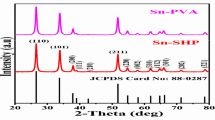Abstract
Novel nanoparticle organic hybrid materials (NOHMs), which have the potential for carbon dioxide physical-chemical capture capacity, have been synthesized. Multi-walled nanotubes (MWNTs), which have the physical storage capacity for gas, were assembled as the core of NOHMs. The surface of MWNTs was functionalized with Jeffamine M-2070 and M-1000 (polyetheramines), which can absorb carbon dioxide via chemical reaction. The structure of NOHMs was verified by Fourier transform infrared (FTIR) spectroscopy, X-ray photoelectron spectroscopy (XPS), and UV-Vis spectroscopy. The weight percentages of MWNTs in NOHMs are 22.1 wt% and 21.4 wt%, respectively. Differential scanning calorimetry (DSC) curves show that the relative crystallinity percent of NOHMs-M2070 and NOHMs-M1000 is 38.88 and 40.56 %, respectively. Transmission electron microscopy (TEM) images show the morphology and structure of NOHMs at the nanometer level. Theological properties of NOHMs exhibit the viscosity and elasticity of NOHMs generated from liquid-like behavior varying the temperature and stress. CO2 capture capacity is tested from 0 to 6 MPa at 298 K. The amine groups, ether groups, and physical interaction between MWNTs and JEFFAMINE have significant effect on CO2 capture capacity. The storage property of MWNTs contributes to CO2 capture capacity. NOHMs based on MWNTs with excellent regeneration capacity have the promising potential for CO2 capture.














Similar content being viewed by others
References
Espinal L, Poster DL, Wong-Ng W, Allen AJ, Green ML (2013) Measurement, standards, and data needs for CO2 capture materials: a critical review. Environ Sci Technol 47:11960–11975
Olivier Jos GJ, Janssens-Maenhout G, Peters JAHW (2012) Trends in global CO2 emissions 2012 report. PBL Netherlands Environmental Assessment Agency, The Hague/Bilthoven
Berezin EV, Konovalov IB, Ciais P, Richter A, Tao S, Janssens-Maenhout G, Beekmann M, Schulze ED (2013) Multiannual changes of CO2 emissions in China: indirect estimates derived from satellite measurements of tropospheric NO2 columns. Atmos Chem Phys 13:9415–9438
Bhatti I, Kamarudin KSN, Qureshi K, Ansari AK (2010) Polymeric membranes used in natural gas processing to separate carbon dioxide: the facing problems and solutions. J Environ Sci Eng 4(1):25–33
Zhang CR, Yu SY (1999) Carbon dioxide gas well testing and evaluation methods. Petroleum Industry Press, Beijing, pp 58–62
Rinker EB, Ashour SS, Sandall OC (2000) Absorption of carbon dioxide into aqueous blends of diethanolamine and methyldiethanolamine. Ind Eng Chem Res 39(11):4346–4356
Singh P, Versteeg GF (2008) Structure and activity relationships for CO2 regeneration from aqueous amine-based absorbents. Process Saf Environ Prot 86(5):347–359
Daniel J, Fauth T, Elizabeth A (2005) Eutectic salt promoted lithium zirconate: novel high temperature sorbent for CO2 capture. Fuel Process Technol 86:1503–1521
Thiruvenkatachari R, Su S, An H, Yu XX (2009) Post combustion CO2 capture by carbon fibre monolithic adsorbents. Prog Energy Combust Sci 35:438–455
Tan YM, Zheng YP, Wang N, Ab Z (2012) Controlling the properties of solvent-free Fe3O4 nanofluids by corona structure. Nano-Micro Lett 4(4):208–214
Zhang JX, Zheng YP, Yu PY, Mo S, Wang RM (2009) The synthesis of functionalized carbon nanotubes by hyperbranched poly- (amine-ester) with liquid-like behavior at room temperature. Polymer 50:2953–2957
Zhang JX, Zheng YP, Lan L, Shi Q, Wu MF, Lu S, Yan C (2013) The preparation of a silica nanoparticle hybrid ionic nanomaterial and its electrical properties. RSC Adv 3:16714–16719
Zheng YP, Zhang AB, Tan YM, Wang N, Yu PY (2013) Property-structure relationship of titania ionic liquid nanofluids. Soft Mater 11(3):315–320
Wu F, Zheng YP, Qu P, Wang N, Chen LX (2013) A liquid-like multiwalled carbon nanotube derivative and its epoxy nanocomposites. J Appl Polym Sci: 2217–2224.
Michael FL, Volder D, Tawfick SH, Baughman RH, Hart AJ (2013) Carbon nanotubes: present and future commercial applications. Science 339(1):535–539
Rodrigueza R, Herrerab R, Bourlinosa AB, Lic RP, Amassianc A, Archerb LA, Giannelisa EP (2010) The synthesis and properties of nanoscale ionic materials. Appl Organometal Chem 24:581–589
Lan L, Zheng YP, Zhang AB, Zhang JX, Wang N (2012) Study of ionic solvent-free carbon nanotube nanofluids and its composites with epoxy matrix. J Nanopart Res 14:753–762
Shao L, Bai YP, Huang X, Gao ZF, Meng LH, Huang YD, Ma J (2009) Multi-walled carbon nanotubes (MWCNTs) functionalized with amino groups by reacting with supercritical ammonia fluids. Mater Chem Phys 116:323–326
Zhang JX, Zheng YP, Lan L, Mo S, Yu PY, Shi W, Wang RM (2009) Direct synthesis of solvent-free multiwall carbon nanotubes/silica nonionic nanofluid hybrid material. ACSNANO 3(8):2185–2190
Georgakilas V, Kordatos K, Prato M, Guldi DM, Holzinger M, Hirsch A (2002) Organic functionalization of carbon nanotubes. J Am Chem Soc 124(5):760–761
Dyke CA, Tour JM (2003) Unbundled and highly functionalized carbon nanotubes from aqueous reactions. Nano Lett 3:1215–1223
Bourlinos AB, Chowdhury SR, Herrera R, Jiang DD, Zhang Q, Archer LA, Giannelis EP (2005) Functionalized nanostructures with liquid-like behavior: expanding the gallery of available nanostructures. Adv Funct Mater 15:1285–1290
Li Q, Dong LJ, Fang JF, Xiong CX (2010) Property structure relationship of nanoscale ionic materials based on multiwalled carbon nanotubes. ACSNANO 4(10):5797–5806
Lin KY, Park AHA (2011) Effects of bonding types and functional groups on CO2 capture using novel multiphase systems of liquid-like nanoparticle organic hybrid materials. Environ Sci Technol 45:6633–6639
Park Y, Decatur J, Lin KY, Park AHA (2011) Investigation of CO2 capture mechanisms of liquid-like nanoparticle organic hybrid materials via structural characterization. Phys Chem Chem Phys 13:18115–18122
Petit C, Bhatnagar S, Park AHA (2013) Effect of water on the physical properties and carbon dioxide capture capacities of liquid-like nanoparticle organic hybrid materials and their corresponding polymers. J Colloid Interface Sci 407:102–108
Acknowledgments
The fund for this work is supported by National Natural Science Foundations (51373137), and graduate starting seed fund of Northwestern Polytechnical University (Z2014067).
Author information
Authors and Affiliations
Corresponding author
Rights and permissions
About this article
Cite this article
Qu, P., Zheng, Y., Yang, R. et al. Effect of canopy structures on CO2 capture capacity and properties of NONMs. Colloid Polym Sci 293, 1623–1634 (2015). https://doi.org/10.1007/s00396-015-3537-4
Received:
Revised:
Accepted:
Published:
Issue Date:
DOI: https://doi.org/10.1007/s00396-015-3537-4




